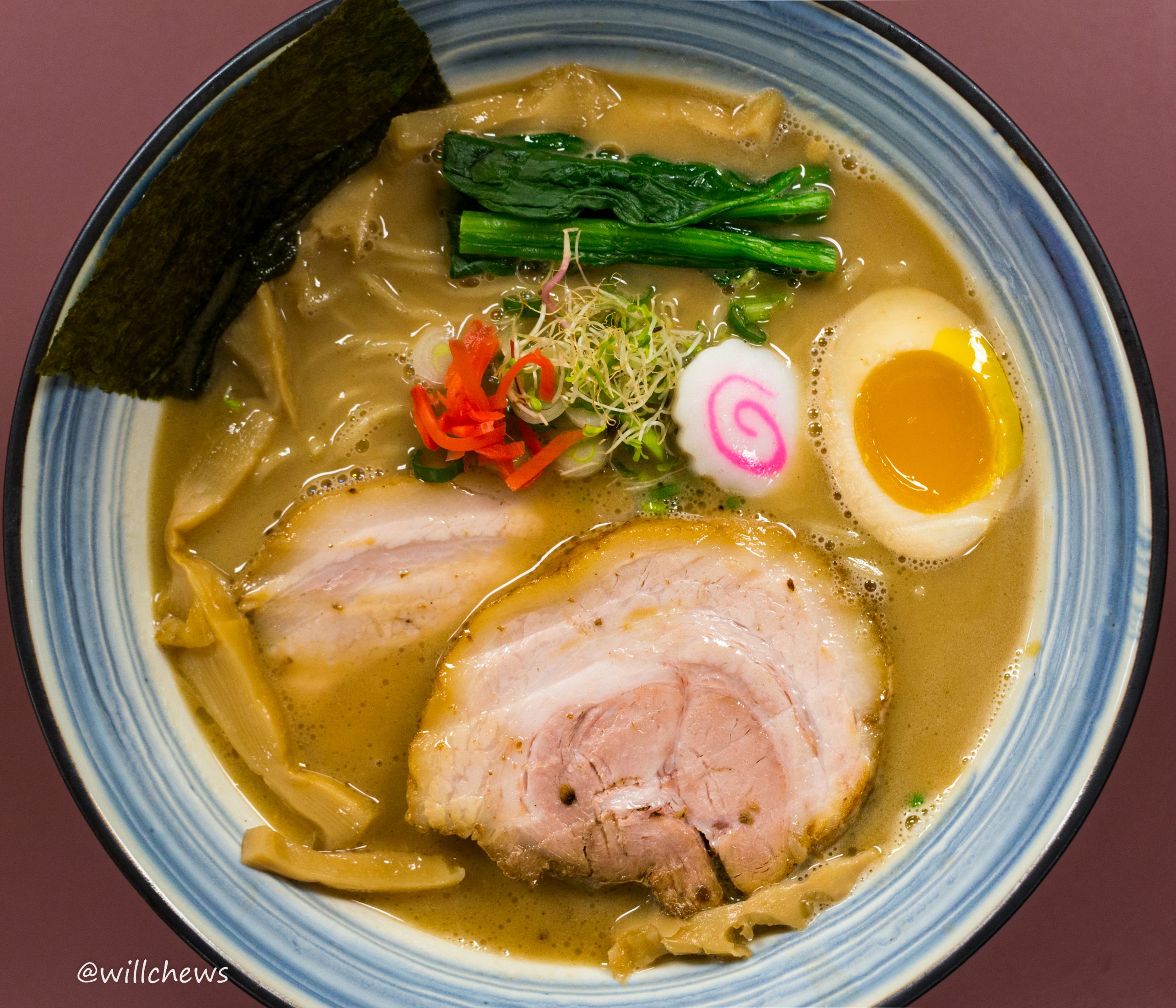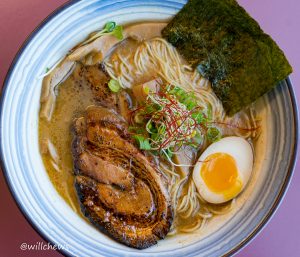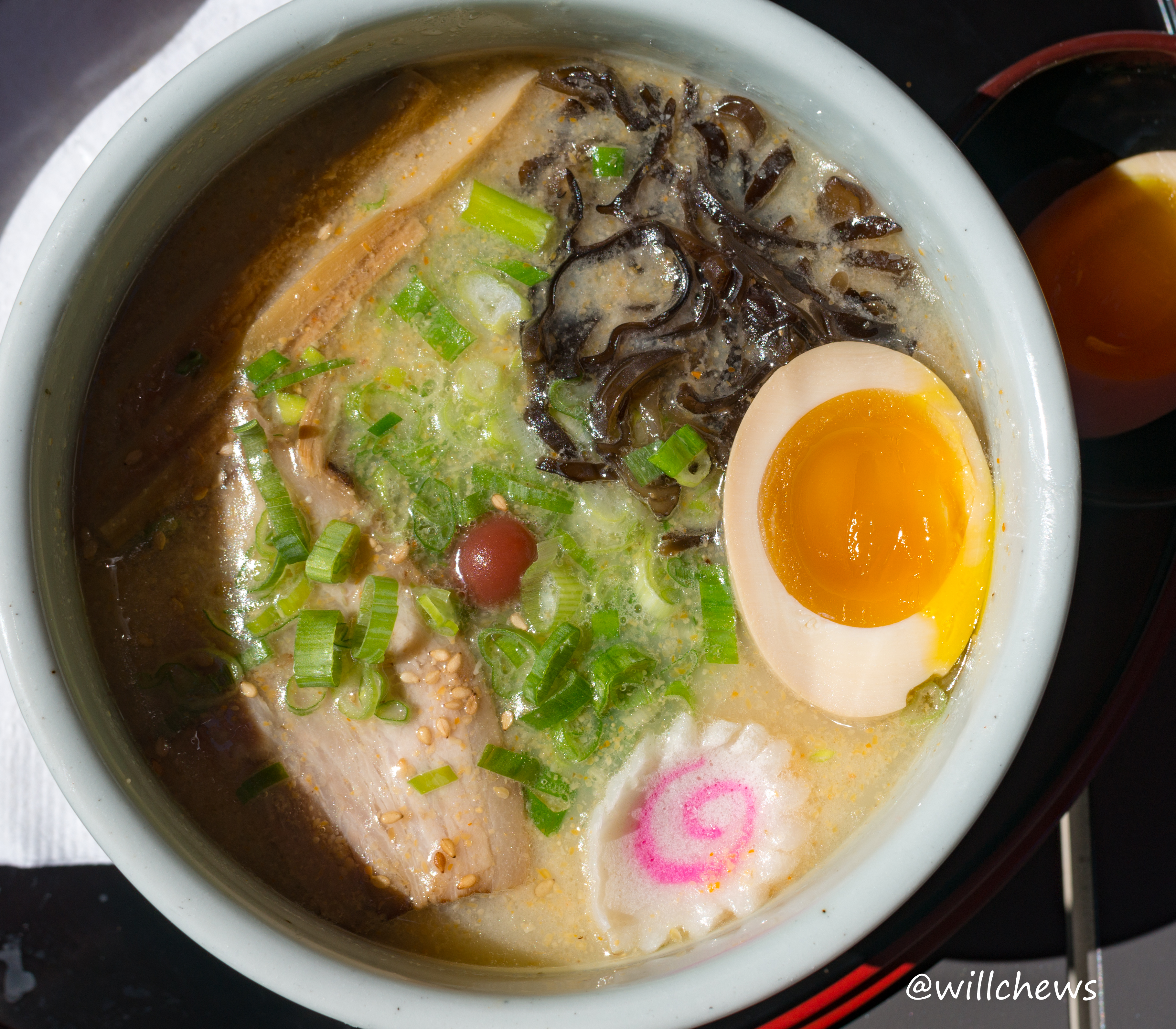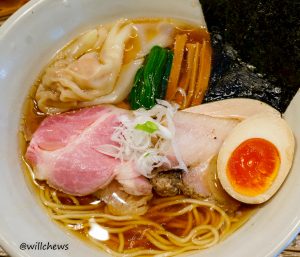In honor of Menya Hosaki’s DC grand opening in September, I’ll be uploading a seven-part/bowl review in the next few weeks. This is Part 4.
This is where Chef Eric Yoo’s constant experimentation at Hosaki pays dividends for budding ramen enthusiasts: gyokai. Gyokai (魚介, “seafood”) is a flavor that one rarely encounters in American ramen shops, but it’s very popular in Japan and Tokyo especially, and is a component of some of my favorite ramen in Japan, such as Sansanto, Honda, and a few others. Seeing “gyokai” on the Hosaki menu drew me to the shop initially, and this bowl was my first introduction to Eric’s tonkotsu-gyokai (pork bone and seafood) ramen.
I’ll digress a bit to describe what a prototypical tonkotsu-gyokai broth should be. First, its name mandates that it must have a lot of pork and seafood flavor, and the style usually features a rich, creamy broth owing to the tonkotsu. In addition to this richness, tonkotsu-gyokai broth can also be infused with a bit of what I describe as “grittiness,” the tiny leavings of pork bone that gets pulverized in the tonkotsu cooking process. Straight-up tonkotsu shops scoop out the gritty bits, but for tonkotsu-gyokai shops such as Tomita (no. 47)–one of the leaders for ramen of this style–this grittiness and smoky, slightly-sour notes from the gyokai are hallmarks of this style. Grittiness and smoky/sour notes are not required for a good tonkotsu-gyokai, as the bowls from Hayashi and Kissou (no. 39) will attest. But many good shops feature such characteristics, and tasting it in an American shop is an easy way of showing that the chef knows his/her business.
Hosaki’s rendition was quite good, achieving the requisite level of creaminess. The name of the bowl suggested that it should have some chicken flavor in there as well, though I felt that its impact was pretty muted. This, according to Eric, owed in part to his decision to put proportionately less chicken bones compared to the other two for the stock, and that the primary purpose of the chicken was to use the collagen in the chicken feet to increase the creaminess of the broth.
With regards to grittiness/smokiness, Hosaki’s bowl exhibited plenty of both without resorting to the extremes of Tomita and Hayashi. The seafood flavors were more prominent here than in his Triple Threat because the latter only uses gyokai dashi rather than fish bones and other more substantial ingredients. That said, I still think Eric could dial up the seafood aspect just a bit more (from a 7 up to a 9 on a 11-point scale) so it could really blow the socks off of American eaters and challenge them with novel and bold flavors. This is an approach that Tsujita LA (no. 133) does very well with their the tonkotsu-gyokai tsukemen.
With regards to grittiness/smokiness, Hosaki’s bowl exhibited plenty of both without resorting to the extremes of Tomita and Hayashi. The seafood flavors were more prominent here than in his Triple Threat because the latter only uses gyokai dashi rather than fish bones and other more substantial ingredients. That said, I still think Eric could dial up the seafood aspect just a bit more (from a 7 up to a 9 on a 11-point scale) so it could really blow the socks off of American eaters and challenge them with novel and bold flavors. This is an approach that Tsujita LA (no. 133) does very well with their the tonkotsu-gyokai tsukemen.
The other components and toppings were a mixed bag and the real reason why this bowl is a Tier 2 and not Tier 1. The ever-present ingredients in Hosaki bowls–the noodles, ajitama egg, spinach–were up to their usual very good-to-excellent standards. The thick-cut roast pork belly chashu was not blowtorched for this ramen, and I think my preference is for it to be torched, though it’s possible that that might create some flavor dissonance with the smokey aspects of the broth. A much bigger issue I had was the choice to include alfalfa sprouts and beni shoga (red ginger) into the bowl. Neither worked for me: the alfalfa imparted an off-putting alkali flavor and odor to the bowl, while the beni shoga was too sharp in flavor and neither combined nor contrasted well with the rest of the bowl. I thought Hosaki would have been better served to stick with shiraga negi (white-haired leek) or chopped green onions as a topping and shared this view with Eric, but he may well disagree.
Overall, this is a fine rendition of a tonkotsu-gyokai ramen. Even if the toppings were swapped out, I’m still not sure if the broth is enough to get it to a Tier 1 since I would like the gyokai flavors to more pronounced. But it comes awfully close to Tier 1, and even if it remains unmodified–unlikely given Eric’s propensity to experiment and improve–it’s something that I’ll definitely get again.
Q Factor: None (Weekend 1930); 15 minute wait for the ramen
Price: Gyokai-Tori-Ton Ramen ($19) + Tax/Tip
Sense: It’s nice to drop in in the evening for once.



